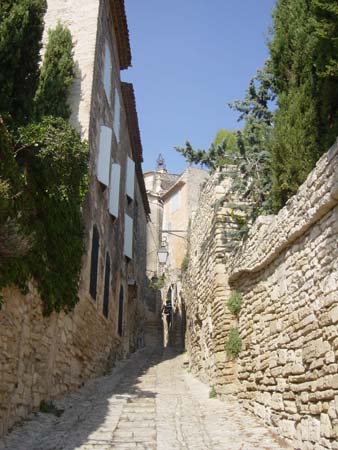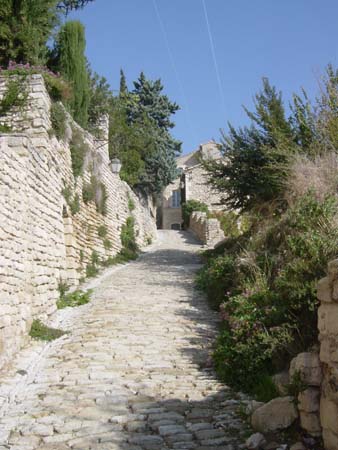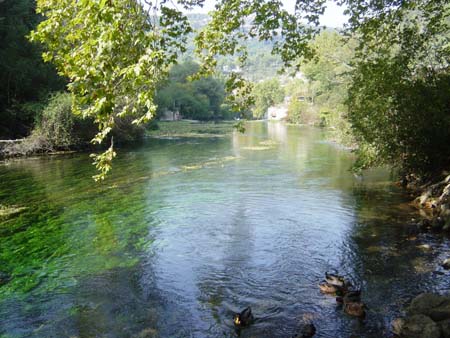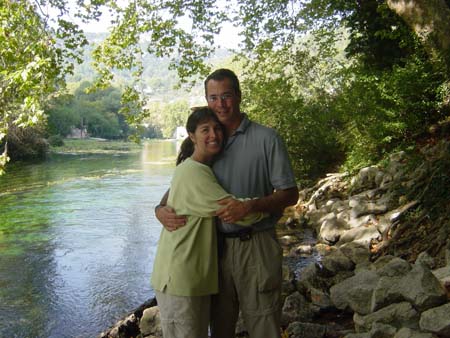Thursday, October 16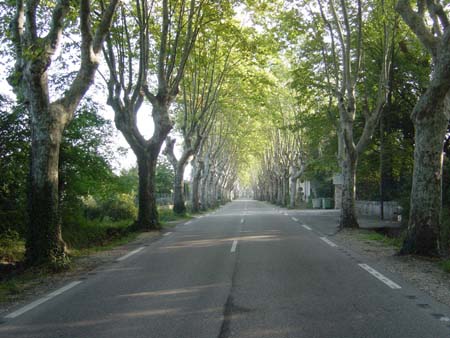
Paula: We enjoyed the Luberon Valley so much earlier this week that we just had to go back again. There were several more towns to explore, plus a natural spring and caves that we wanted to see. So with today's fantastic weather, we were off!
Along the way, we stopped to take pictures of the "plane trees"
(this is what the French call them, and they're a type of sycamore) which
line many of the country roads in Provence. These trees stand out in our minds
as a defining characteristic of the area. Perhaps because we are just coming
from Tuscany where cy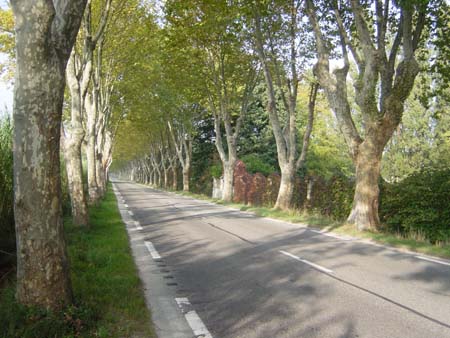 press
trees, olive groves and vineyards make up so much of the landscape, these
things no longer seem different to us. However, the plane trees and the way
they line the roads are unique. They have been planted close together and
pruned over the years so that they make the roadways look like tunnels. The
trees all look almost identical, creating a very interesting effect on the
roads, especially around curves. The bark on the trees is also lovely - like
that of a Birch tree. We took several pictures, but they don't really capture
the true effect - this memory will have to live in our minds.
press
trees, olive groves and vineyards make up so much of the landscape, these
things no longer seem different to us. However, the plane trees and the way
they line the roads are unique. They have been planted close together and
pruned over the years so that they make the roadways look like tunnels. The
trees all look almost identical, creating a very interesting effect on the
roads, especially around curves. The bark on the trees is also lovely - like
that of a Birch tree. We took several pictures, but they don't really capture
the true effect - this memory will have to live in our minds.
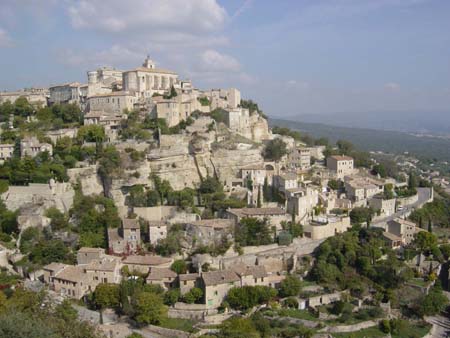
Our first stop in the Luberon Valley today was the hilltop town of Gordes.
The road to Gordes provides a striking view of the entire town. There is a
beautiful Renaissance chateau and church at its peak with the rest of the
town built on terraces below. We enjoyed exploring the narrow streets and
beautiful views, and every corner revealed another photo opportunity for Steve
and Katie. From this height, the burning of fields in October was quite visible
and this has 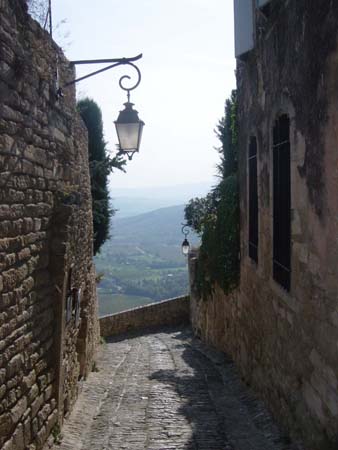 made
the air hazier over the past week. Farmers do this to prepare their land for
the next year, but we've heard conflicting information about whether this
is really useful. We enjoyed a delicious lunch at a small café run
by two older gentleman. The café had room for only 8 people and we
watched them prepare our meal in their small kitchen next to the small dining
area. It was great!
made
the air hazier over the past week. Farmers do this to prepare their land for
the next year, but we've heard conflicting information about whether this
is really useful. We enjoyed a delicious lunch at a small café run
by two older gentleman. The café had room for only 8 people and we
watched them prepare our meal in their small kitchen next to the small dining
area. It was great! 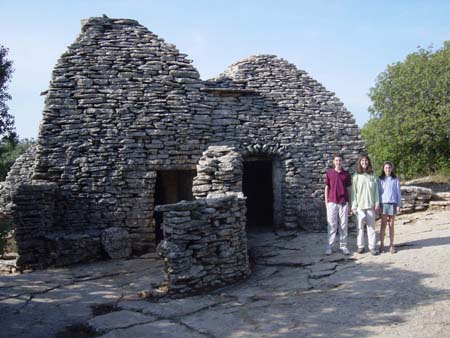
Before leaving Gordes, we stopped by the small village at the foot of the
town called Village des Bories. This village is no longer inhabited but comprises
ancient stone dwellings called bories. The bories, here and in other parts
of the Provence countryside, date back to 3,500BC making them the oldest buildings
we have seen so far on our trip. 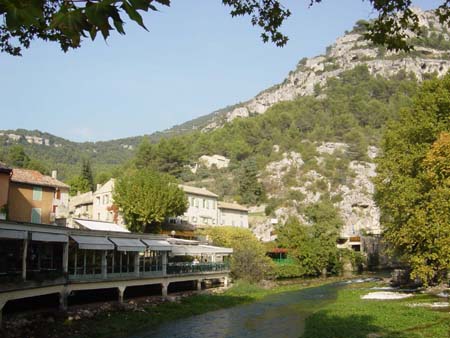
Our next stop was Fontaine-de-Vaucluse. This small town is named after the
natural wonder it is built around. The Sorgue River begins underground as
water drains from the Vaucluse plateau and then rushes above ground from a
spring at Fontaine-de-Vaucluse. The spring is over 1,000 feet deep (they didn't
determine this until 1985 when they sent a submarine down) and after winter
the water flowing from the spring into the river apparently 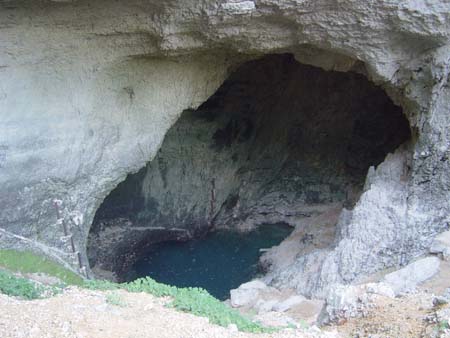 makes
impressive rapids. The spring and river were calm today especially given the
lack of rain this season. The surrounding cliffs were still impressive and
we enjoyed throwing rocks into the deep spring and floating homemade boats
down the river. The water was so clear that we could see plants, moss and
even the river trout clearly. The combination of the clear water and the wonderful
color of the plants was especially beautiful.
makes
impressive rapids. The spring and river were calm today especially given the
lack of rain this season. The surrounding cliffs were still impressive and
we enjoyed throwing rocks into the deep spring and floating homemade boats
down the river. The water was so clear that we could see plants, moss and
even the river trout clearly. The combination of the clear water and the wonderful
color of the plants was especially beautiful.
After leaving Fontain-de-Vaucluse, we spent time reflecting on how many of
these small villages we've enjoyed here in Provence. These places are very
charming, and it's been wonderful to simply wander through the narrow streets,
stop in shops, and admire the surrounding views. We've certainly been the
beneficiary of good timing - the weather's been nearly perfect every day,
and there are very few visitors here so late in the season. We definitely
made the right decision to delay our time in Provence until the fall (originally
we had contemplated coming here in July, which would have been a big mistake).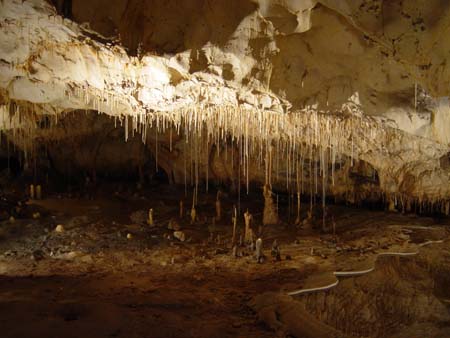
Our final stop was the Grottes de Thouzon. This cave was discovered in1902
during excavations in the limestone quarry. The cave is 60 million years old
and a fossil bed of an old underground stream. We marveled at the stalactites
and stalagmites and the amazing natural history of the earth. There were also
hundreds of "macaronis," icicle-like structures formed by drips
of water and calcium carbonate. These 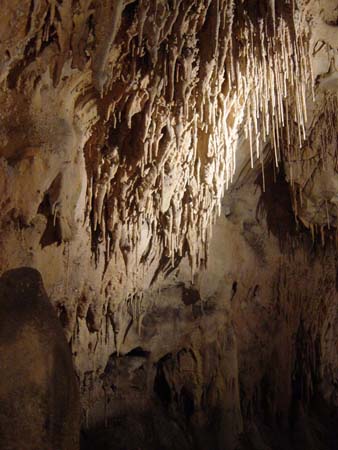 amazing
structures hanging from the ceiling gave the cave a very spooky effect. We
saw one "macaroni" that is over 13,000 years old and still growing
at a rate of 1 centimeter per century! Amazingly, we saw tree roots (still
alive) that had grown 20-50 meters through the limestone to get into the cave
and its water source. We thoroughly enjoyed this science lesson before heading
back to Arles.
amazing
structures hanging from the ceiling gave the cave a very spooky effect. We
saw one "macaroni" that is over 13,000 years old and still growing
at a rate of 1 centimeter per century! Amazingly, we saw tree roots (still
alive) that had grown 20-50 meters through the limestone to get into the cave
and its water source. We thoroughly enjoyed this science lesson before heading
back to Arles.
Before heading to bed, we contemplated what time to wake up and check score of the final game of the Red Sox series against the Yankees. We have missed being a part of the excitement of the playoffs - it's very difficult to have to follow things from so far away via the internet. Steve and David have decided that they'll wake up at 4:30 AM to see what's happening in the game…
Tomorrow we hope to take a hike along a ridge that runs between Les Baux and St. Remy. The forecast is for rain (this would be our first bad day since we arrived in Provence), so we may end up packing, cleaning and catching up on errands instead.
Distance Walked: 1.89 miles
